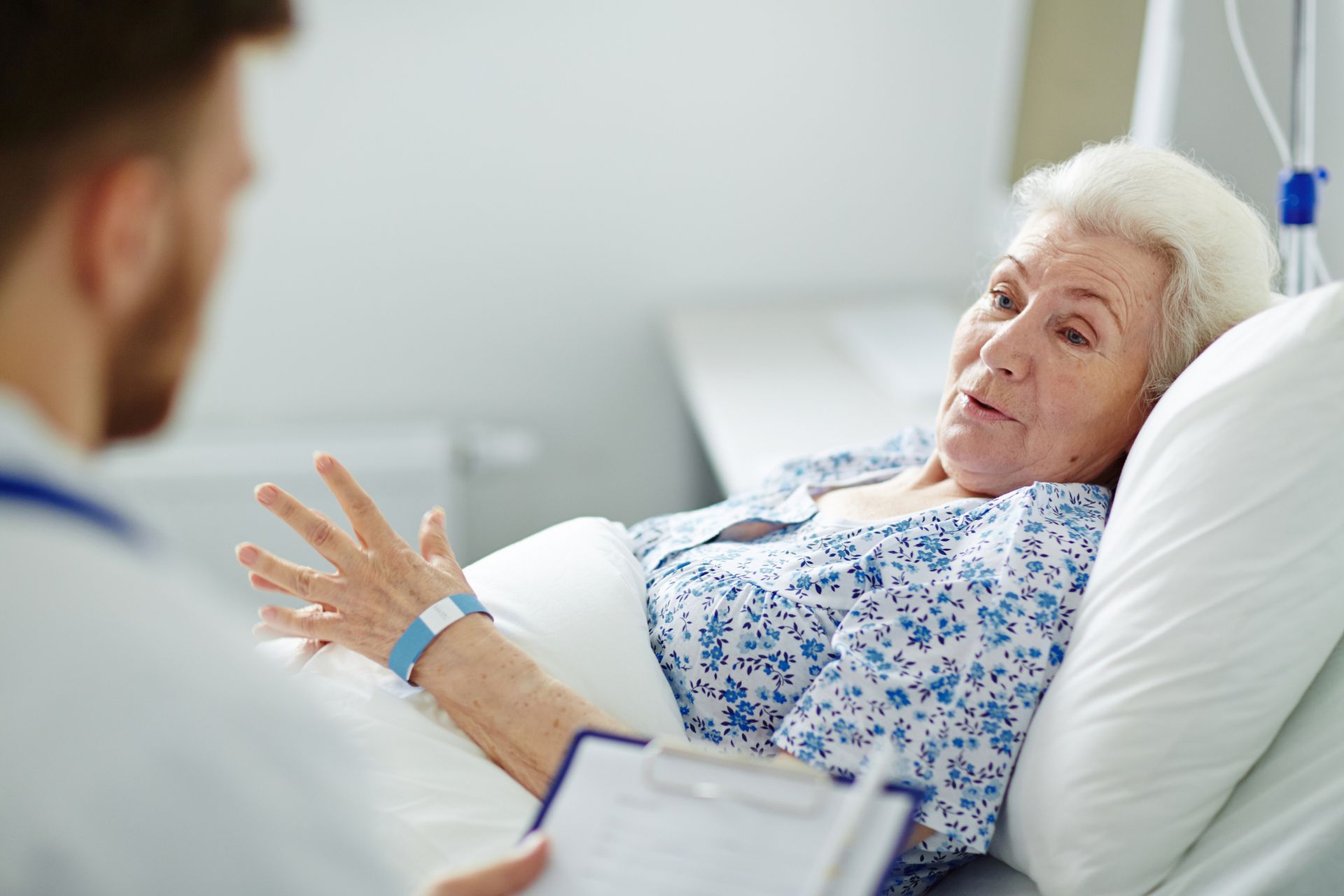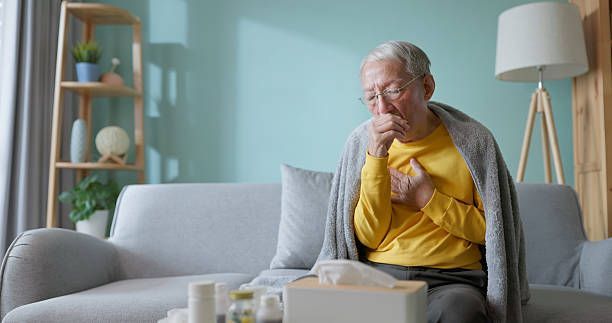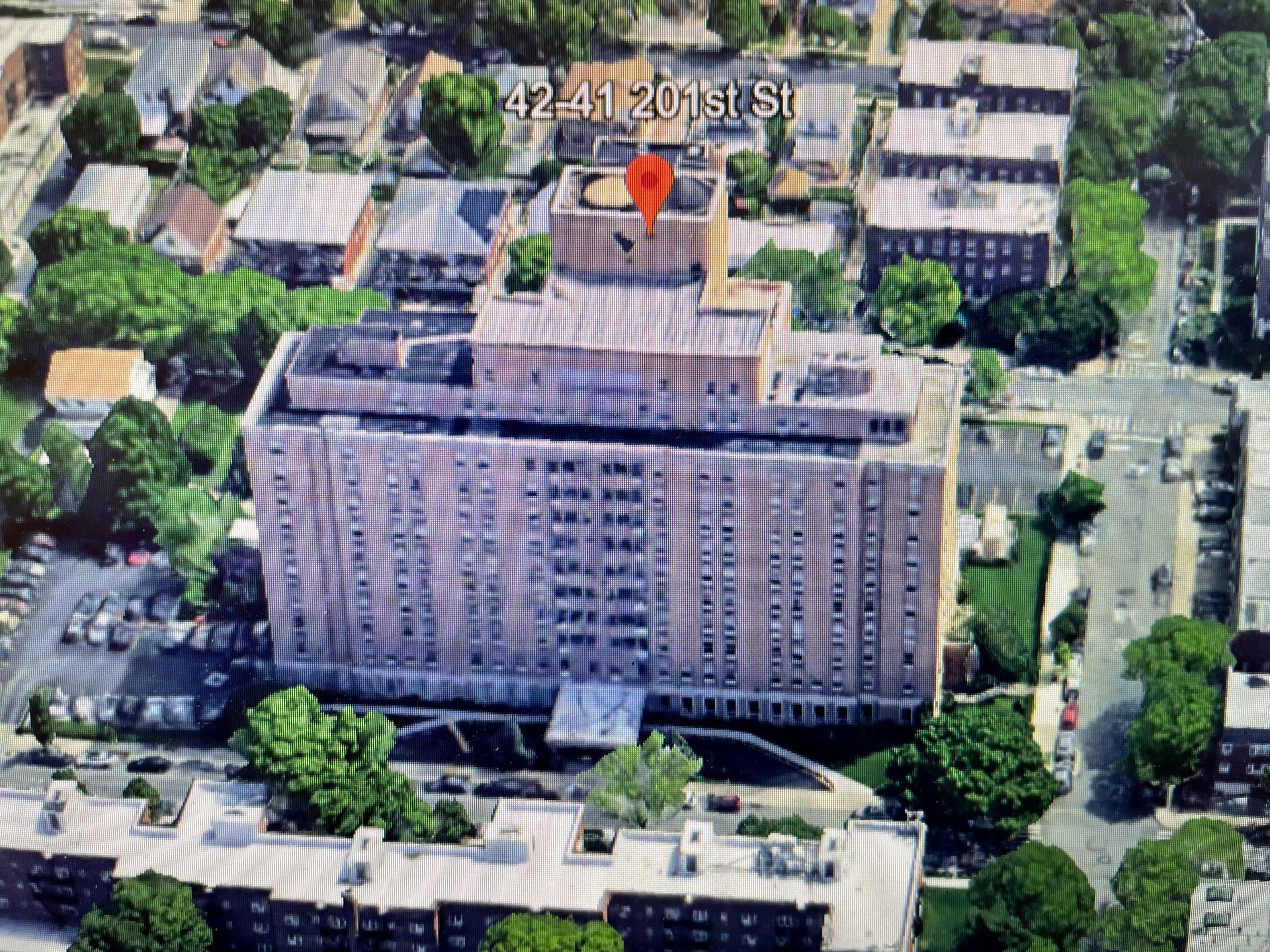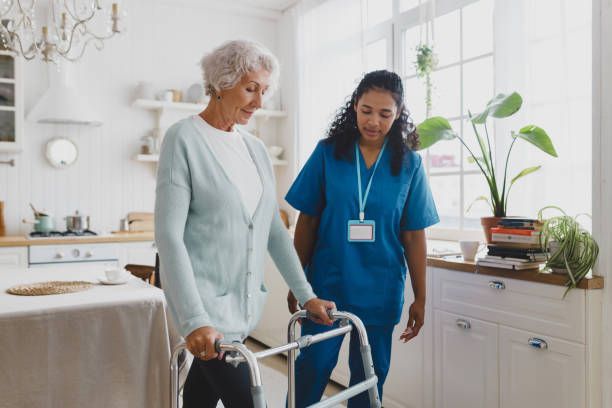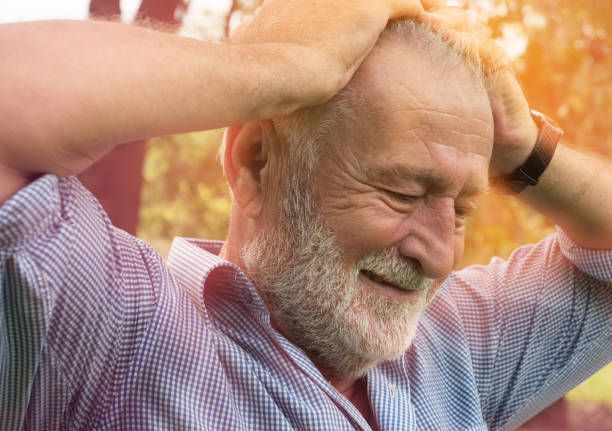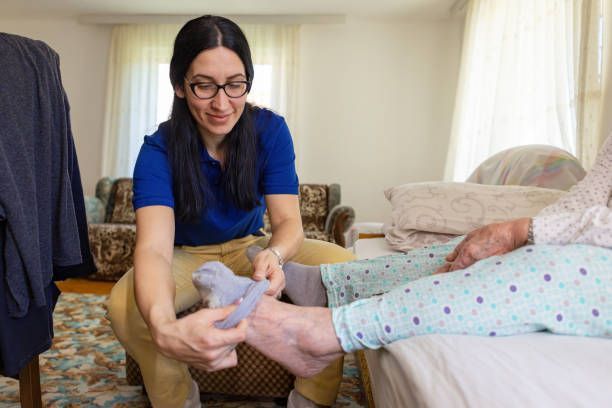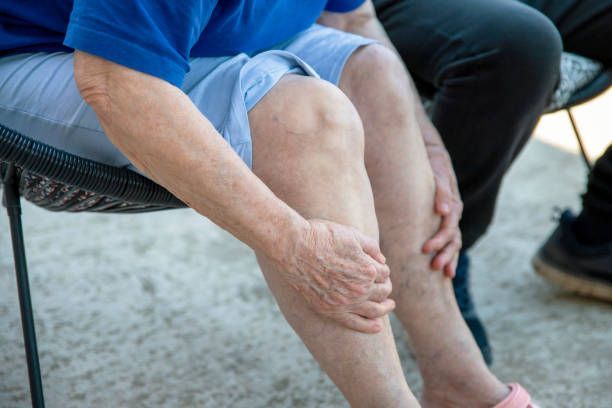Elderly Mobility Scale (EMS): Complete Assessment Guide
The Elderly Mobility Scale (EMS) is one of the most valuable yet underused tools in senior care—and its absence in family planning can lead to serious, preventable risks. Designed to measure how safely and independently an older adult can move, stand, and walk, the EMS provides a clear, evidence-based snapshot of mobility and fall risk. Unfortunately, many families rely on observation or assumption instead of objective assessment, missing early signs of decline that could lead to falls, hospitalization, or loss of independence. By incorporating the EMS into regular home-care evaluations, families and caregivers can identify mobility problems before they become emergencies—keeping loved ones safe, active, and thriving at home.
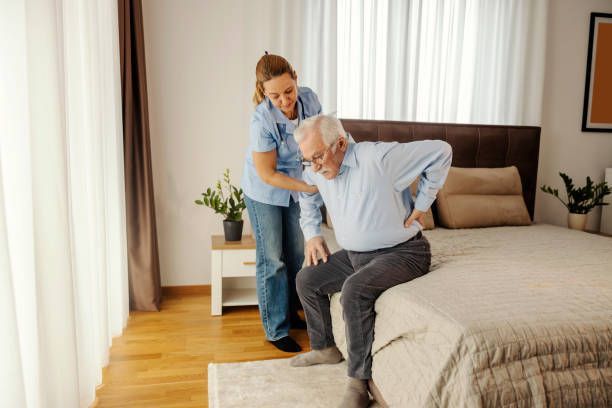
What Is the Elderly Mobility Scale?
The Elderly Mobility Scale (EMS) is a validated 7-item assessment tool that measures functional mobility in older adults. Developed by physiotherapist R. Smith in 1994, it evaluates how independently seniors can perform essential movements like standing from a chair, walking, and transferring from bed. Scores range from 0-20, with higher scores indicating greater independence and lower fall risk.
What Is a Normal EMS Score?
EMS scores are interpreted based on three functional categories that predict care needs and fall risk:
Score Interpretation Guide
14-20 points: Independent
- Can perform most daily activities without assistance
- Low fall risk with appropriate home safety measures
- Generally safe to live independently or with minimal support
- May benefit from preventive exercise programs
10-13 points: Borderline/Moderate Assistance
- Requires some help with transfers or walking
- Moderate fall risk requiring safety interventions
- May need assistive devices (walker, cane, grab bars)
- Benefits from part-time home care assistance
- Candidate for physical therapy to improve function
0-9 points: Dependent/High Assistance
- Needs significant help with most mobility tasks
- High fall risk requiring constant supervision
- May require 24-hour care or facility-level support
- Benefits from comprehensive rehabilitation programs
- Often requires multiple assistive devices
Age-Related Score Expectations
While the EMS doesn't have strict age-based norms, clinical studies show typical patterns:
- Ages 65-75 (healthy community-dwelling): Average 17-19
- Ages 75-85 (with chronic conditions): Average 13-16
- Ages 85+ (frail elderly): Average 10-14
- Post-hospitalization (any age): Often 8-12 initially
Important note: Individual scores vary widely based on health conditions, not just age. A healthy 85-year-old may score higher than an unhealthy 70-year-old.
How Do You Perform the Elderly Mobility Scale?
The EMS assessment takes 10-15 minutes and requires minimal equipment: a bed, a stable chair without arms, a stopwatch, measuring tape, and approximately 6 meters of clear walking space.
Step-by-Step EMS Administration
Preparation:
- Ensure patient wears regular footwear (not slippers)
- Clear walkway of obstacles and hazards
- Have the patient rest 5 minutes before starting
- Explain that you'll be assessing their usual mobility
- Position yourself to assist if needed but don't help unless necessary
Task 1: Lying to Sitting
What to assess: Patient lies flat on bed and sits up on edge of bed
Scoring:
- 2 points: Sits up independently without using hands for support
- 1 point: Sits up using hands for support or requires steadying
- 0 points: Unable to sit up without significant assistance
Clinical note: Observe for dizziness upon sitting (orthostatic hypotension risk).
Task 2: Sitting to Lying
What to assess: Patient lowers from sitting position to lying flat on bed
Scoring:
- 2 points: Lies down independently with control
- 1 point: Uses hands for support or requires some assistance
- 0 points: Unable to lie down safely without significant help
Clinical note: This tests eccentric muscle control and fall prevention during lowering movements.
Task 3: Sit to Stand
What to assess: Patient stands up from chair without using arms for support
Scoring:
- 3 points: Stands independently without using arms
- 2 points: Stands using arms of chair for support (or one hand)
- 1 point: Stands with physical assistance from assessor
- 0 points: Unable to stand even with assistance
Clinical note: This is one of the strongest predictors of future fall risk and functional decline.
Task 4: Standing (Static Balance)
What to assess: Patient stands unsupported for 10 seconds
Scoring:
- 3 points: Stands steady and safe for 10 seconds
- 2 points: Stands for 10 seconds but unsteady (swaying, needs to catch balance)
- 1 point: Stands less than 10 seconds or needs support
- 0 points: Unable to stand without continuous physical support
Clinical note: Watch for Romberg sign (eyes closed makes it worse = vestibular/proprioceptive issue).
Task 5: Gait (Walking Quality)
What to assess: Observe walking pattern and safety
Scoring:
- 3 points: Normal gait, safe, no walking aids needed
- 2 points: Independent with walking aid (cane, walker, etc.)
- 1 point: Walks with physical assistance from one person
- 0 points: Unable to walk or requires two-person assistance
Clinical note: Assess stride length, arm swing, posture, and foot clearance for specific deficits.
Task 6: Timed Walk (6 Meters)
What to assess: Time taken to walk 6 meters (approximately 20 feet)
Scoring:
- 3 points: Completes in less than 15 seconds
- 2 points: Completes in 15-30 seconds
- 1 point: Completes in more than 30 seconds
- 0 points: Unable to walk 6 meters
Clinical note: Use "go" command and start timing when first foot moves. Stop when both feet cross 6-meter line.
Task 7: Functional Reach
What to assess: Standing, patient reaches forward as far as possible without stepping
Scoring:
- 2 points: Reaches forward more than 10 inches (25 cm)
- 1 point: Reaches forward less than 10 inches
- 0 points: Unable to reach forward or needs support to avoid falling
Clinical note: This tests dynamic balance and trunk control during reaching activities common in daily life.
Calculating Total Score
Add all task scores together for a total between 0-20 points. Record the score along with date, assessor name, and any observations about patient effort, pain, or environmental factors that may have affected performance.
What Does My EMS Score Mean for Daily Living?
Understanding what your EMS score means in practical terms helps families plan appropriate care and safety measures:
Score 18-20: Excellent Functional Mobility
What this means:
- Independent in virtually all mobility tasks
- Can safely navigate home environment
- Low risk for falls with basic safety precautions
- Can participate in community activities
Recommended actions:
- Continue regular exercise to maintain function
- Annual reassessment or if health changes
- Basic home safety (adequate lighting, remove trip hazards)
- Consider preventive balance exercises
Score 14-17: Good Functional Mobility
What this means:
- Generally independent but may have minor limitations
- May use assistive device for distance or outdoor walking
- Low-moderate fall risk requiring some precautions
- Can manage most activities of daily living
Recommended actions:
- Physical therapy evaluation for strengthening
- Consider assistive devices for challenging situations
- Home safety assessment and modifications
- Regular exercise program focusing on balance and strength
- Reassess every 3-6 months
Score 10-13: Moderate Impairment
What this means:
- Requires assistance with some mobility tasks
- May need help with bathing, dressing, or transfers
- Moderate-high fall risk requiring supervision
- Difficulty with stairs or uneven surfaces
Recommended actions:
- Part-time home care for mobility assistance and safety
- Physical therapy for targeted strengthening
- Assistive devices (walker, raised toilet seat, grab bars)
- Remove all trip hazards and improve lighting
- Consider medical alert system
- Reassess monthly or with any change in condition
Score 5-9: Significant Impairment
What this means:
- Needs help with most mobility and personal care
- High fall risk requiring close supervision
- May need wheelchair for distance mobility
- Difficulty transferring safely without assistance
Recommended actions:
- Daily home care or 24-hour supervision recommended
- Comprehensive physical therapy evaluation
- Multiple assistive devices and home modifications
- Bathroom safety equipment essential
- Medical evaluation for treatable causes of decline
- Consider occupational therapy for adaptive techniques
- Weekly reassessment during rehabilitation
Score 0-4: Severe Impairment
What this means:
- Requires maximum assistance for all mobility
- Cannot safely walk or transfer without help
- Very high fall risk even with assistance
- May be bedbound or wheelchair-dependent
Recommended actions:
- 24-hour care essential for safety
- Hospital bed, mechanical lift may be needed
- Skilled nursing assessment for medical causes
- Pressure ulcer prevention protocols
- Regular repositioning to prevent complications
- Hospice consultation if appropriate
- Immediate reassessment with any change
When Should the EMS Be Performed?
Timing EMS assessments appropriately ensures meaningful results and guides care decisions:
Initial Assessment Situations
Hospital discharge planning:
- 24-48 hours before discharge to determine home care needs
- Helps predict readmission risk and safety at home
- Guides equipment orders and home modifications
Starting home care services:
- Establishes baseline functional mobility level
- Determines appropriate caregiver training needs
- Documents starting point for measuring progress
After a fall or near-fall:
- Identifies specific mobility deficits contributing to fall risk
- Guides targeted interventions to prevent future falls
- Documents change from previous functional level
New diagnosis affecting mobility:
- Stroke, Parkinson's disease, arthritis flare, hip fracture
- Establishes post-diagnosis baseline
- Monitors impact of medical treatments
Noticeable decline in function:
- Family reports increased difficulty with walking or transfers
- Patient using furniture for support more than before
- Takes longer to complete familiar tasks
Follow-Up Assessment Timing
During active rehabilitation: Weekly or biweekly to track progress and adjust therapy goals
Stable chronic conditions: Every 3-6 months to detect gradual decline early
After illness or hospitalization: 2 weeks post-discharge, then monthly for 3 months
Before major care decisions: Before moving to assisted living, increasing care hours, or discharge from therapy
Annual wellness checks: Even stable seniors benefit from yearly mobility assessment
How Accurate Is the Elderly Mobility Scale?
The EMS has been extensively validated in clinical research and demonstrates excellent measurement properties:
Reliability Evidence
Inter-rater reliability: Multiple studies show correlation coefficients of 0.95-0.97, meaning different assessors get nearly identical scores for the same patient.
Test-retest reliability: When the same patient is tested twice within 24 hours (with no intervention between), scores are highly consistent (r = 0.92-0.96).
Internal consistency: The seven tasks correlate well with each other (Cronbach's alpha 0.80-0.89), indicating they all measure aspects of the same construct: functional mobility.
Validity Evidence
Concurrent validity: EMS scores correlate strongly with other validated measures:
- Barthel Index: r = 0.80-0.88
- Timed Up and Go: r = -0.70 (negative correlation - lower TUG time = higher EMS score)
- Berg Balance Scale: r = 0.75-0.83
- Functional Independence Measure (FIM): r = 0.72-0.85
Predictive validity: Lower EMS scores predict:
- Future falls (scores <14 associated with 3x fall risk)
- Hospital readmission within 30 days
- Need for institutional care
- Mortality at 6 and 12 months
Responsiveness to change: The EMS detects meaningful improvements after physical therapy, with changes of 2-3 points considered clinically significant.
Clinical Utility Studies
Research demonstrates the EMS effectively identifies:
- 88% sensitivity for detecting fall risk (correctly identifies those who will fall)
- 75% specificity (correctly identifies those who won't fall)
- Discharge readiness from rehabilitation facilities
- Appropriate level of home care assistance needed
What Are the Limitations of the Elderly Mobility Scale?
Understanding EMS limitations helps clinicians and families use it appropriately:
Ceiling Effect for High-Functioning Seniors
The limitation: Very active seniors may all score 19-20 even though their fitness levels differ significantly. A 75-year-old marathon runner and a 75-year-old who walks daily may both score 20, but have vastly different functional capacities.
Solution: For high-functioning seniors, use additional assessments like the Short Physical Performance Battery (SPPB) or 6-Minute Walk Test to differentiate fitness levels.
Does Not Assess Cognitive Function
The limitation: The EMS measures physical ability but not cognitive safety. A person with dementia might score 18 but be unsafe alone due to poor judgment, wandering risk, or inability to call for help after a fall.
Solution: Combine EMS with cognitive screening (Mini-Mental State Exam, Montreal Cognitive Assessment) for comprehensive safety evaluation.
No Endurance or Fatigue Measurement
The limitation: The EMS tests ability to perform each task once, but doesn't measure stamina. A patient might complete the 6-meter walk successfully but be unable to walk to the bathroom and back later in the day due to fatigue.
Solution: Supplement with endurance tests (6-Minute Walk Test, 2-Minute Step Test) and ask about daily fatigue patterns.
Limited Use for Non-Ambulatory Patients
The limitation: Patients who cannot stand or walk will score very low (0-5) on multiple tasks, limiting the EMS's ability to detect meaningful changes in their bed mobility or wheelchair skills.
Solution: Use the Functional Independence Measure (FIM) or modified mobility scales designed for wheelchair users and bedbound patients.
Requires Trained Assessor for Consistency
The limitation: While simple, the EMS requires consistent technique to ensure reliable results. Untrained assessors may give too much help, mistime the 6-meter walk, or misinterpret scoring criteria.
Solution: Ensure all assessors receive standardized training and periodic competency verification.
Floor Effect in Very Impaired Patients
The limitation: Severely impaired patients may score 0-2 consistently, making it difficult to detect small but meaningful improvements during rehabilitation.
Solution: Break down individual tasks into smaller components and document qualitative improvements even when scores don't change.
EMS vs Other Mobility Tests: Which Should You Use?
Different mobility assessments serve different purposes. Understanding when to use each helps ensure appropriate evaluation:
Elderly Mobility Scale (EMS)
Best for:
- Hospitalized or recently discharged seniors
- Frail elderly with multiple limitations
- Home care initial assessment and ongoing monitoring
- Rehabilitation progress tracking
- Comprehensive mobility evaluation in 10-15 minutes
Not ideal for:
- High-functioning community-dwelling seniors (ceiling effect)
- Quick screening in busy clinical settings
- Non-ambulatory patients
Timed Up and Go (TUG)
Best for:
- Quick screening tool (takes 2 minutes)
- Community-dwelling seniors with mild limitations
- Primary care office assessment
- Fall risk screening
- Annual wellness exams
Scoring: <10 seconds = normal, 10-20 seconds = mild limitation, >20 seconds = significant mobility impairment
Comparison to EMS: TUG is faster but provides less detailed information; EMS gives comprehensive view but takes longer.
Berg Balance Scale (BBS)
Best for:
- Detailed balance assessment
- Physical therapy evaluation
- Vestibular disorder assessment
- Balance-specific intervention planning
Scoring: 14 tasks, 56 points maximum; <45 indicates high fall risk
Comparison to EMS: BBS focuses exclusively on balance; EMS includes functional mobility tasks like transfers and walking speed.
Barthel Index
Best for:
- Overall functional independence assessment
- Includes self-care tasks (feeding, bathing, toileting)
- Long-term care and disability evaluation
- Insurance documentation
Scoring: 10 items, 100 points maximum
Comparison to EMS: Barthel is broader (includes activities beyond mobility); EMS focuses specifically on movement quality.
Short Physical Performance Battery (SPPB)
Best for:
- Research studies on aging
- Predicting long-term outcomes
- Community-dwelling older adults
- Distinguishing among higher-functioning seniors
Scoring: 3 tests (balance, gait speed, chair stands), 12 points maximum
Comparison to EMS: SPPB better for high-functioning seniors (no ceiling effect); EMS better for hospitalized or frail populations.
Clinical Decision Guide
Use EMS when you need:
- Comprehensive mobility assessment in one tool
- Baseline for rehabilitation or home care
- Assessment of hospitalized or frail seniors
- Evaluation across multiple mobility domains
Use TUG when you need:
- Quick screening in busy primary care
- Annual wellness check
- Initial fall risk assessment
Use Berg Balance when:
- Balance is the primary concern
- Planning balance-specific interventions
- Vestibular rehabilitation
Use Barthel Index when:
- Evaluating overall functional independence
- Insurance or disability determination
- Long-term care facility assessment
Combine multiple tools when:
- Comprehensive evaluation is needed
- Patient has complex presentation
- Planning major care transitions
How to Improve Your EMS Score
For patients and families wanting to enhance mobility and independence, specific interventions can improve EMS scores over time:
Exercises to Improve Specific EMS Tasks
For Lying to Sitting and Sitting to Lying (Tasks 1-2):
- Core strengthening: planks, bridges, seated twists
- Sit-to-stand practice: 10 repetitions 3x daily
- Abdominal exercises: partial sit-ups, leg lifts
- Target improvement: Move from using hands for support to independent movement
For Sit to Stand (Task 3):
- Quad strengthening: leg extensions, mini squats
- Sit-to-stand practice without arm use: start with higher surfaces, progress to standard chair height
- Balance exercises: single-leg stands
- Target improvement: Progress from needing arms for support to standing without assistance
For Standing Balance (Task 4):
- Progressive balance training: start with eyes open/feet apart, progress to feet together/eyes closed
- Tandem standing (heel-to-toe position)
- Single-leg stands: begin with support, work toward 30 seconds each leg
- Tai Chi or yoga for balance improvement
- Target improvement: Reduce swaying and increase standing duration
For Gait Quality (Task 5):
- Walking practice: 20-30 minutes daily
- Obstacle course navigation at home
- Heel-toe walking for coordination
- High-knee marching for foot clearance
- Target improvement: Reduce reliance on assistive devices, improve gait pattern
For Timed 6-Meter Walk (Task 6):
- Speed interval training: alternate normal and faster walking
- Lower extremity strengthening: leg press, calf raises, squats
- Cadence training with metronome
- Cardiovascular conditioning
- Target improvement: Reduce time from >30 seconds to 15-30 seconds category
For Functional Reach (Task 7):
- Trunk flexibility: seated and standing rotations
- Forward reach practice: place objects at increasing distances
- Dynamic balance training: weight shifting exercises
- Shoulder and trunk strengthening
- Target improvement: Increase reach distance beyond 10 inches
Home Modifications That Support EMS Improvement
Environmental changes that enhance safety during practice:
- Install grab bars in bathroom for transfer practice
- Ensure adequate lighting for balance and walking exercises
- Remove trip hazards to create safe practice space
- Place sturdy furniture strategically for support during exercise
- Use non-slip mats in exercise areas
- Set up clear 6-meter walking path for daily practice
Physical Therapy for EMS Score Improvement
What PT can provide:
- Individualized exercise program targeting specific EMS deficits
- Progressive resistance training for strength building
- Balance and coordination training
- Gait training and assistive device fitting
- Home exercise program with proper technique instruction
- Monitoring and adjustment as function improves
Expected improvements with PT: Research shows that with consistent physical therapy (2-3x weekly for 6-8 weeks), many patients improve EMS scores by 3-5 points, which represents clinically meaningful functional gain.
Nutritional Support for Mobility
Key nutrients for mobility improvement:
- Adequate protein (0.8-1.2g per kg body weight daily) for muscle maintenance
- Vitamin D for bone health and fall prevention
- Calcium for bone strength
- Omega-3 fatty acids for inflammation reduction
- Adequate hydration for optimal muscle function
Medical Interventions That May Improve EMS
Address underlying causes of mobility limitation:
- Pain management for arthritis or chronic pain
- Medication review to eliminate drugs causing dizziness or weakness
- Treatment of anemia or thyroid disorders
- Blood pressure optimization
- Vision and hearing correction
- Neuropathy management
- Parkinson's medication optimization
When Should You Be Concerned About EMS Scores?
Certain situations require immediate attention and intervention:
Urgent Concern Indicators
Sudden score drop of 3+ points:
- May indicate new medical problem (stroke, infection, medication reaction)
- Requires immediate physician evaluation
- Could signal delirium, not permanent decline
- Common after hospitalization or new medication
Score below 10 with patient living alone:
- High fall risk without supervision
- May need emergency home care placement
- Safety assessment essential
- Consider medical alert system immediately
Progressive decline over 3-6 months:
- Rule out treatable causes (vitamin deficiency, depression, medication side effects)
- May indicate progression of chronic condition
- Requires care plan reassessment
- Consider increase in home care hours or services
Recent fall with unchanged score:
- Score may not capture all fall risk factors
- Add cognitive and environmental assessment
- Evaluate for orthostatic hypotension, vision problems
- May need 24-hour supervision despite score
Red Flags Requiring Medical Evaluation
- Sudden inability to perform previously mastered tasks
- New confusion or cognitive changes during testing
- Complaints of severe pain during movements
- Shortness of breath or chest pain with minimal activity
- Extreme fatigue disproportionate to effort
- New weakness on one side of body
How Home Care Agencies Use the EMS in New York
Professional home care providers throughout New York integrate the EMS into comprehensive care assessment and planning:
Initial Assessment Process
When 7 Day Home Care begins services: Our registered nurses conduct or review EMS assessments during the initial home visit to:
- Establish baseline mobility status for care planning
- Identify specific fall risks in the home environment
- Determine appropriate caregiver training requirements
- Match client with caregiver experienced in needed assistance level
- Create individualized mobility goals and safety protocols
Care Plan Development Based on EMS
For clients scoring 14-20 (Independent):
- Part-time assistance focusing on medication management, meal preparation
- Companionship and activity encouragement
- Home safety assessment and minor modifications
- Transportation to appointments and therapy
- Monitoring for decline with monthly reassessment
For clients scoring 10-13 (Borderline):
- Daily care 4-8 hours providing transfer assistance
- Bathroom safety supervision
- Fall prevention strategies and environmental modifications
- Exercise encouragement and physical therapy coordination
- Assistive device management and training
- Weekly nursing reassessment
For clients scoring 0-9 (Dependent):
- 24-hour care or multiple daily shifts
- Total assistance with transfers and personal care
- Comprehensive fall prevention protocols
- Mechanical lift use if needed
- Close medical monitoring and family communication
- Hospice coordination when appropriate
Progress Monitoring in New York Home Care
Regular reassessment schedule:
- Monthly EMS for clients in rehabilitation or showing changes
- Quarterly EMS for stable clients with chronic conditions
- After any fall, hospitalization, or significant health change
- Before increasing or decreasing care hours
Documentation and communication:
- EMS scores documented in client medical record
- Changes reported to family and physicians
- Used for insurance authorization when applicable
- Guides staffing decisions and caregiver training updates
Coordination with New York Healthcare Providers
Hospital discharge transitions: Many New York hospitals including Mount Sinai, NYU Langone, and NewYork-Presbyterian include mobility assessments in discharge planning. 7 Day Home Care coordinates with hospital discharge planners to:
- Review pre-discharge EMS or similar mobility scores
- Plan appropriate home care intensity based on scores
- Arrange equipment delivery before patient arrives home
- Schedule initial nursing visit for reassessment within 48 hours
Physical therapy collaboration: We work with outpatient PT providers throughout Manhattan, Queens, Brooklyn, and Long Island to:
- Reinforce therapy exercises between sessions
- Monitor for decline between therapy visits
- Communicate progress or concerns
- Support therapy goals in daily care activities
Primary care physician communication:
- Share EMS results with patient's doctor
- Report significant changes or declines
- Request medical evaluation for treatable causes of decline
- Coordinate care plan adjustments based on medical recommendations
New York-Specific Considerations
Urban environment challenges:
- High-rise buildings requiring elevator safety considerations
- Narrow apartment hallways affecting assistive device use
- Stairs in brownstones and walk-up buildings
- Public transportation navigation for appointments
- Weather-related mobility challenges
Diverse population needs:
- Multilingual assessment and communication
- Cultural considerations in mobility and care preferences
- Immigration-related Medicare/Medicaid variations
- Family structure and involvement patterns
10 FAQ: Complete Guide to the Elderly Mobility Scale
1. What is the Elderly Mobility Scale used for?
The Elderly Mobility Scale measures functional mobility in older adults to predict fall risk, determine care needs, guide rehabilitation, and track changes over time. Scores from 0-20 indicate independence level and help healthcare providers make safety recommendations.
2. How long does the EMS take to complete?
The Elderly Mobility Scale takes 10-15 minutes to complete. It includes seven tasks: lying to sitting, sitting to lying, sit to stand, standing balance, walking, timed 6-meter walk, and functional reach.
3. What is a good EMS score for elderly patients?
A score of 14-20 indicates good functional mobility with independence in most tasks. Scores of 10-13 suggest moderate impairment needing some assistance, while scores below 10 indicate significant mobility limitations requiring substantial help.
4. Can family members perform the EMS at home?
While the EMS requires trained assessor for most accurate results, family members can learn the basic scoring to monitor changes. However, formal assessments should be conducted by healthcare professionals (nurses, physical therapists) for care planning decisions.
5. What equipment do you need for the Elderly Mobility Scale?
You need a bed, a stable armless chair, a stopwatch, measuring tape, and approximately 6 meters (20 feet) of clear walking space. No specialized medical equipment is required.
6. How often should the EMS be performed?
Perform EMS monthly during active rehabilitation, every 3-6 months for stable chronic conditions, after any fall or hospitalization, and annually for preventive wellness assessment in healthy seniors.
7. What's the difference between EMS and Timed Up and Go?
The EMS is a comprehensive 7-task assessment taking 10-15 minutes, while Timed Up and Go (TUG) is a single 2-minute screening test. EMS provides more detailed mobility information; TUG is better for quick screening in primary care.
8. Is the Elderly Mobility Scale still used today?
Yes, the EMS remains widely used in hospitals, rehabilitation centers, and home care agencies worldwide. It's particularly valuable in geriatric settings for its balance of comprehensiveness and practicality.
9. What interventions improve EMS scores?
Physical therapy, strength and balance exercises, proper nutrition, treating underlying medical conditions (pain, anemia, vision problems), appropriate assistive devices, and home safety modifications all can improve EMS scores over time.
10. What does an EMS score of 12 mean?
A score of 12 indicates borderline mobility with moderate assistance needs. The person requires help with some transfers or walking, has moderate fall risk, and benefits from part-time home care and physical therapy to prevent further decline.
The EMS as a Tool for Maintaining Independence
The Elderly Mobility Scale is more than a clinical assessment—it's a roadmap for helping older adults maintain the independence and dignity that mobility provides. By objectively measuring functional abilities, the EMS guides families, caregivers, and healthcare providers in creating safe, effective care plans tailored to each person's specific needs.
Understanding your or your loved one's EMS score empowers you to:
- Recognize when additional support is needed before a crisis occurs
- Set realistic goals for rehabilitation and improvement
- Make informed decisions about care intensity and living arrangements
- Track progress over time and celebrate meaningful improvements
- Prevent falls and maintain safety while maximizing independence
At 7 Day Home Care, we believe mobility is fundamental to quality of life. Our comprehensive assessments, including mobility evaluations like the EMS, ensure every client receives care precisely matched to their functional abilities and safety needs. Whether you're recovering from hospitalization in Manhattan, managing chronic conditions in Queens, navigating aging in Brooklyn, or maintaining independence on Long Island, our experienced team uses evidence-based tools to deliver personalized, effective care.
Mobility challenges don't have to mean loss of independence. With proper assessment, targeted interventions, and appropriate support, most older adults can maintain functional mobility and continue living safely in the homes and communities they love.
Contact 7 Day Home Care today at (516) 408-0034 or visit here to schedule a comprehensive mobility assessment and learn how our registered nurses and certified caregivers can help you or your loved one maintain independence, prevent falls, and thrive at home. 7 Day Home Care is the top private pay and long term care insurance in-home care services provider throughout Manhattan, Long Island, NYC, Queens, and Brooklyn, New York.
Brian Callahan
7 Day Home Care
